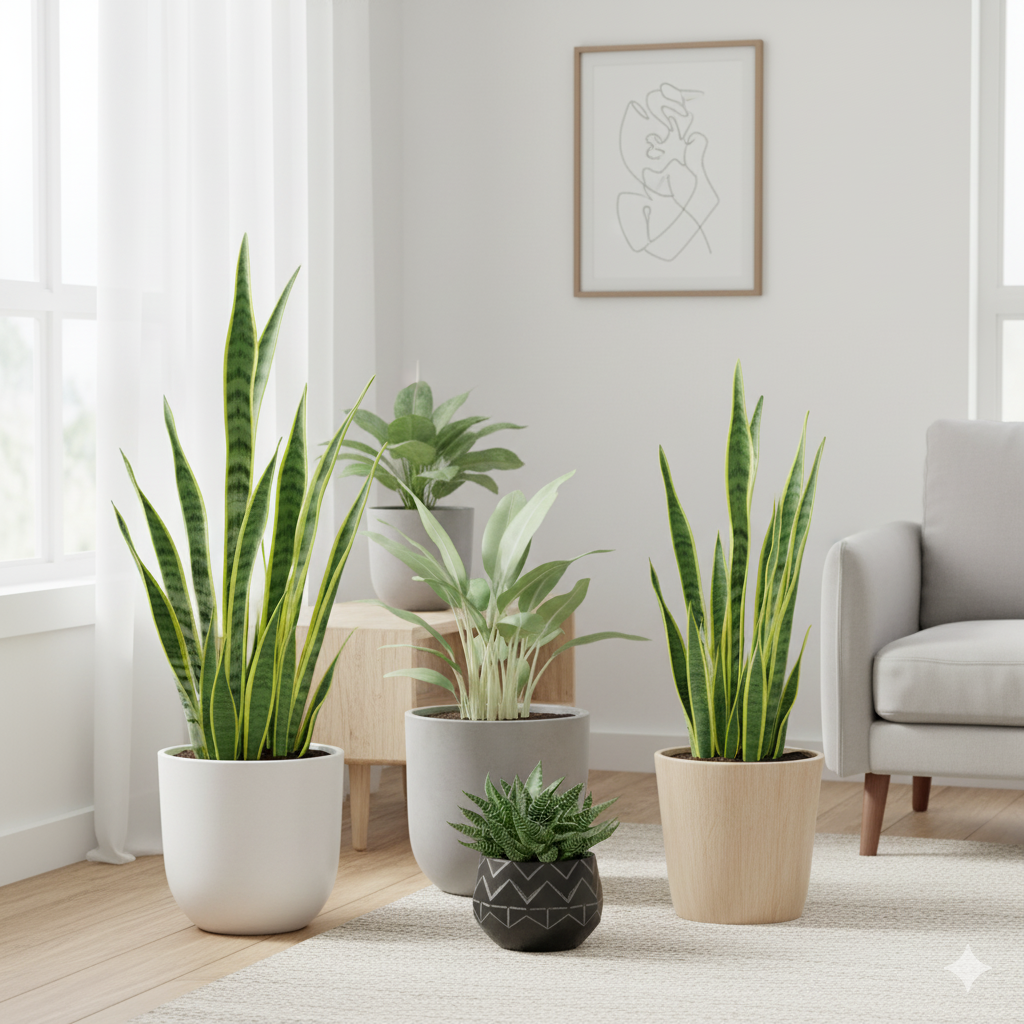Introduction to Snake Plants
Snake plants, scientifically known as Sansevieria, have gained immense popularity in recent years as houseplants, making them an ideal choice for individuals seeking a blend of aesthetics and practicality in modern home décor. Their unique architectural form, characterized by tall, upright leaves that can exhibit striking variegation, makes them a visually appealing addition to various interior spaces. Ranging from deep green to lighter shades with gold or silver accents, these plants cater to diverse style preferences, seamlessly fitting contemporary, minimalist, or even eclectic designs.
One of the standout benefits of snake plants is their low maintenance nature. These hardy plants thrive in a variety of conditions, from low light to direct sunlight, making them suitable for nearly any room in a home, including bedrooms, living rooms, and even offices. Their ability to survive with minimal watering further enhances their appeal, as they require infrequent attention compared to other houseplants. This adaptability makes them an excellent option for busy individuals or those new to gardening.
Additionally, snake plants are recognized for their air-purifying qualities. According to research conducted by NASA, these plants can remove toxins such as benzene, formaldehyde, and xylene from indoor air, contributing to a healthier living environment. This aspect is particularly beneficial in modern homes where indoor air quality can often be compromised by pollution and volatile organic compounds (VOCs) emitted from various household items. By incorporating snake plants into your home décor, you can enhance the visual appeal of your space while simultaneously reaping the health benefits associated with improved air quality.
Overall, the snake plant serves as a versatile and stylish enhancement to modern home interiors, making it a top contender for those looking to elevate their living spaces. With its unique appearance and numerous advantages, this plant deserves a prominent place in any home décor scheme.
Top Snake Plant Varieties
When considering indoor plants that complement modern home décor, snake plants stand out for their unique appearance and resilience. Among the most popular varieties is the Sansevieria Trifasciata, commonly known as Mother-in-Law’s Tongue. This variety features tall, upright leaves that exhibit a stunning mix of dark green and lighter green horizontal stripes. Known for its air-purifying properties, this plant flourishes in low light conditions, making it an excellent choice for various indoor settings.
Another notable variety is the Sansevieria Cylindrica, often referred to as the cylindrical snake plant. This plant is characterized by its round, tube-like leaves that grow vertically and can reach impressive heights. Its unique shape adds a striking element to modern interiors, and the leaves often boast a rich green color with subtle lighter bands, offering a bold aesthetic. Due to its hardy nature, this snake plant variety thrives on minimal care and adapts well to various light conditions.
Additionally, the Sansevieria Laurentii is highly favored for its eye-catching appearance. This variety has sword-like leaves with a vibrant green center and striking yellow edges, creating a dramatic contrast. The Sansevieria Laurentii typically grows to a medium height, making it an ideal statement piece when placed in stylish planters. Its ability to flourish in indirect sunlight further enhances its appeal for indoor use.
These snake plant varieties not only contribute to healthier air quality but also elevate the aesthetic of any room. Their varied growth habits and leaf patterns allow for personal expression and versatility, making them suitable for a diverse range of interior styles. By selecting the right variety, individuals can enhance their home décor while enjoying the benefits of low-maintenance plant care.
Styling with Snake Plants
Incorporating snake plants into modern home décor offers both aesthetic appeal and practical benefits. Known for their resilience and air-purifying qualities, these plants can enhance various rooms with minimal effort. One effective way to style snake plants is by placing them on shelves or tables to create visual interest. A tall, slender variety can act as a stunning focal point in a corner or beside a window, drawing the eye upwards and adding dimension to the space.
For those with limited floor space, consider using snake plants on floating shelves. By combining different heights and types of snake plants, one can create an attractive vertical garden effect. Additionally, grouping smaller varieties in a cluster on a coffee table or console can provide a pop of greenery without overwhelming the room’s design. Their architectural shape complements both contemporary and minimalist interiors, making them versatile companions in various settings.
The choice of pot or container plays a crucial role in the overall look. Opting for minimalist designs can underscore the clean lines of modern décor, while terracotta pots bring a rustic warmth that contrasts beautifully with the sleekness of snake plants. Decorative planters, such as those made from ceramic or metal, can serve as statement pieces, further enhancing the décor. When selecting pots, consider colors and textures that harmonize with existing furnishings, creating a cohesive visual flow throughout the space.
In summary, snake plants can be seamlessly integrated into modern home décor through thoughtful placement and complementary containers. Experimenting with different styles and arrangements can inspire creativity, allowing these hardy plants to shine as both decorative elements and functional additions to the home.
Care Tips for Snake Plants
Snake plants, also known as Sansevieria or mother-in-law’s tongue, are attractive and resilient plants that can enhance modern home décor. These hardy species are well-suited for busy homeowners, as they require minimal maintenance while adding a striking element to various interior settings. Understanding how to care for these plants will ensure they thrive in your home.
Watering is a critical aspect of snake plant care. It is essential to allow the soil to dry out completely between watering sessions. Overwatering can lead to root rot, which is detrimental to the plant’s health. Typically, watering every two to six weeks is sufficient, depending on the humidity and temperature of your environment. During the growing season, spring and summer, providing water more frequently can be beneficial, while in the colder months, reducing water intake is advisable.
Light conditions play a significant role in the growth of snake plants. These adaptable plants can thrive in a range of lighting scenarios, from low light to bright, indirect sunlight. However, it is essential to avoid direct sunlight, as this can scorch the leaves. Placing snake plants in a well-lit room, but away from harsh rays, will promote healthy growth and vibrant foliage.
When it comes to soil, snake plants prefer a well-draining potting mix. Cactus or succulent soil blends work exceptionally well, as they prevent moisture accumulation around the roots. If you prefer to create your own mix, combining regular potting soil with perlite or sand can enhance drainage capabilities.
Despite their hardiness, snake plants can occasionally face pest issues, with mealybugs and spider mites being the most common. Regularly inspecting your plants and maintaining cleanliness will help manage these pests. If infestations are detected, using a gentle insecticidal soap or neem oil is effective in eradication. These measures emphasize the snake plant’s resilience and adaptability, assuring homeowners of their ability to care for these beautiful additions to home décor with ease.





